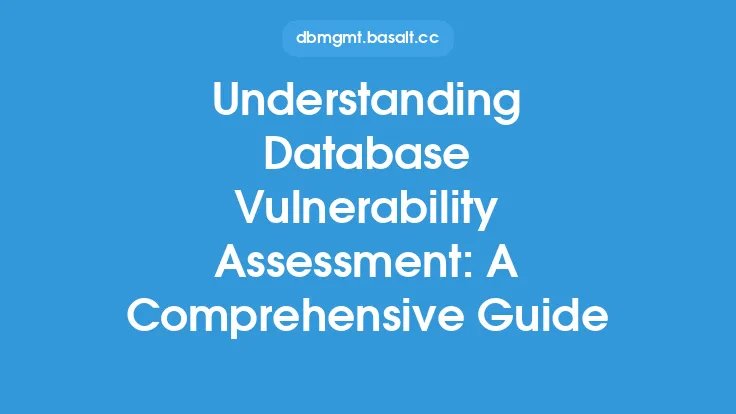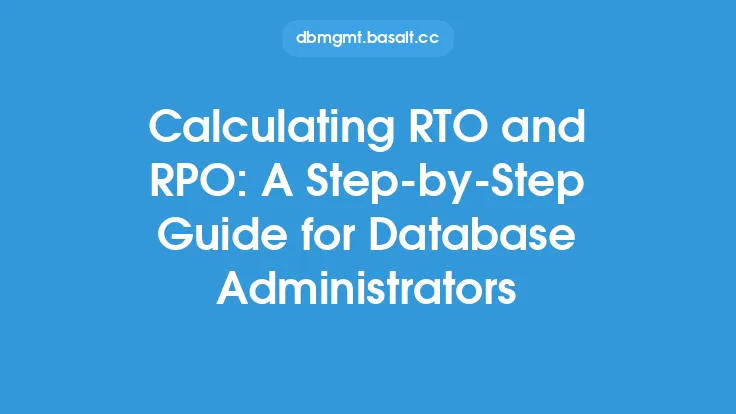Database capacity planning is a critical aspect of database design, as it ensures that the database can handle the required workload and scale to meet future demands. It involves analyzing the database's current and future needs, identifying potential bottlenecks, and making informed decisions about resource allocation. Effective database capacity planning is essential to prevent performance issues, data loss, and downtime, which can have significant consequences for businesses and organizations.
Introduction to Database Capacity Planning Concepts
Database capacity planning involves understanding the key concepts of database performance, scalability, and resource utilization. It requires a deep understanding of the database's architecture, including the underlying hardware, software, and network infrastructure. The goal of database capacity planning is to ensure that the database can handle the required workload, which includes the number of users, transactions, and data volume. This involves analyzing the database's current and future needs, identifying potential bottlenecks, and making informed decisions about resource allocation.
Understanding Database Workload and Performance
To plan database capacity effectively, it's essential to understand the database workload and performance characteristics. The workload refers to the amount of activity on the database, including the number of queries, transactions, and data modifications. Performance characteristics, such as response time, throughput, and latency, are critical in determining the database's ability to handle the workload. Database administrators must monitor and analyze performance metrics, such as CPU utilization, memory usage, and disk I/O, to identify potential bottlenecks and areas for optimization.
Database Capacity Planning Methodologies
There are several methodologies for database capacity planning, including the predictive, reactive, and proactive approaches. The predictive approach involves using historical data and trends to forecast future demand and plan capacity accordingly. The reactive approach involves responding to performance issues and capacity constraints as they arise, which can be costly and disruptive. The proactive approach involves continuously monitoring and analyzing performance metrics, identifying potential issues, and making informed decisions about resource allocation and capacity upgrades. A combination of these approaches is often the most effective way to plan database capacity.
Database Sizing and Capacity Planning Considerations
Database sizing and capacity planning involve considering several factors, including the number of users, data volume, and transaction rate. The database size and capacity must be sufficient to handle the required workload, with some buffer for growth and unexpected spikes in activity. Database administrators must also consider the storage requirements, including the amount of disk space needed for data, indexes, and logs. Additionally, they must consider the computational resources required, including CPU, memory, and network bandwidth.
Database Architecture and Capacity Planning
The database architecture plays a critical role in determining the capacity and performance of the database. A well-designed database architecture can help to improve performance, reduce latency, and increase scalability. Database administrators must consider the database schema, indexing strategy, and query optimization techniques when planning capacity. They must also consider the underlying hardware and software infrastructure, including the server configuration, storage subsystem, and network topology.
Capacity Planning for Different Database Types
Different types of databases have unique capacity planning requirements. For example, relational databases, such as Oracle and MySQL, require careful planning of storage, indexing, and query optimization. NoSQL databases, such as MongoDB and Cassandra, require planning for data distribution, replication, and scalability. Cloud-based databases, such as Amazon Aurora and Google Cloud SQL, require planning for instance types, storage, and network bandwidth. Database administrators must understand the specific requirements of their database type and plan capacity accordingly.
Best Practices for Database Capacity Planning
There are several best practices for database capacity planning, including monitoring and analyzing performance metrics, identifying potential bottlenecks, and making informed decisions about resource allocation. Database administrators should also consider implementing automation and orchestration tools to simplify capacity planning and management. Additionally, they should consider implementing a capacity planning framework that includes regular reviews and updates to ensure that the database capacity meets the evolving needs of the organization.
Common Challenges in Database Capacity Planning
Database capacity planning can be challenging, especially in complex and dynamic environments. Common challenges include predicting future demand, identifying potential bottlenecks, and making informed decisions about resource allocation. Database administrators must also contend with limited resources, including budget, personnel, and infrastructure. Additionally, they must consider the risks associated with over-provisioning or under-provisioning, which can result in wasted resources or performance issues.
Future of Database Capacity Planning
The future of database capacity planning is likely to involve increased use of automation, artificial intelligence, and machine learning. These technologies can help to simplify capacity planning and management, improve prediction accuracy, and reduce the risk of human error. Additionally, the increasing adoption of cloud-based databases and containerization is likely to change the way database capacity is planned and managed. Database administrators must stay up-to-date with the latest trends and technologies to ensure that their database capacity planning strategies remain effective and efficient.





